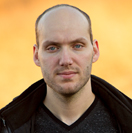 In theory, you should be able to fully recharge a lithium ion battery as many times as you want. But in reality, there’s less power each time you recharge, and even on that first cycle, a battery never reaches full capacity.
In theory, you should be able to fully recharge a lithium ion battery as many times as you want. But in reality, there’s less power each time you recharge, and even on that first cycle, a battery never reaches full capacity.
Shawn Sallis wants to know why.
“It’s unclear what’s causing the problem,” says Sallis, a doctoral candidate in materials science and engineering at Binghamton University. “The electrodes start as a powder, which is mixed with a liquid binder to create a paste. That makes it really hard to disentangle exactly what’s going on as the material starts to degrade, and it’s going to require a lot of work to find out.”
To solve the puzzle, Sallis is spending this school year on a prestigious fellowship at the Lawrence Berkeley National Laboratory, in Berkeley, Calif., where he’ll be working with the Advanced Light Source (ALS), a synchrotron that produces a beam a billion times brighter the sun. By bombarding his materials with X-rays, Sallis can observe the electrons as the battery charges and recharges, and gain a better understanding how the surface and subsurface degrade.
“We need facilities like the one in Berkeley to answer why we’re not reaching the full potential of these materials,” says Louis Piper, an assistant professor of physics who serves as Sallis’ faculty advisor. “They’re not behaving as they should, and we suspect the differences between the surface and the interior of these nanoparticles that make the electrodes is responsible. If we can determine what’s occurring, then we can consider how to overcome the problem. Over the past few years, Shawn has gained a lot of experience, which makes him the natural candidate.”
Since coming to Binghamton in 2010, Sallis has co-authored 17 published papers, presented his work at five national conferences and won an award for Best Poster for the oxide semiconductors symposium at the fall 2012 Meeting of the Materials Research Society. He has already conducted research at ALS, as well as at the National Synchrotron Light Source on Long Island and at Diamond Light Source in the United Kingdom.
“It’s very expensive to make the kind of X-rays we need to do this work,” says Sallis, who grew up in rural Cortland County, the son of a nurse and a long-haul truck driver, before graduating from SUNY Cortland in 2010. “Improving batteries is going to be a long, hard process with a lot of incremental steps. So I’m really excited to go back to ALS, where I’ll be able to focus on my research, help other people with their experiments, and see a lot of science I wouldn’t find anywhere else in the world.”







